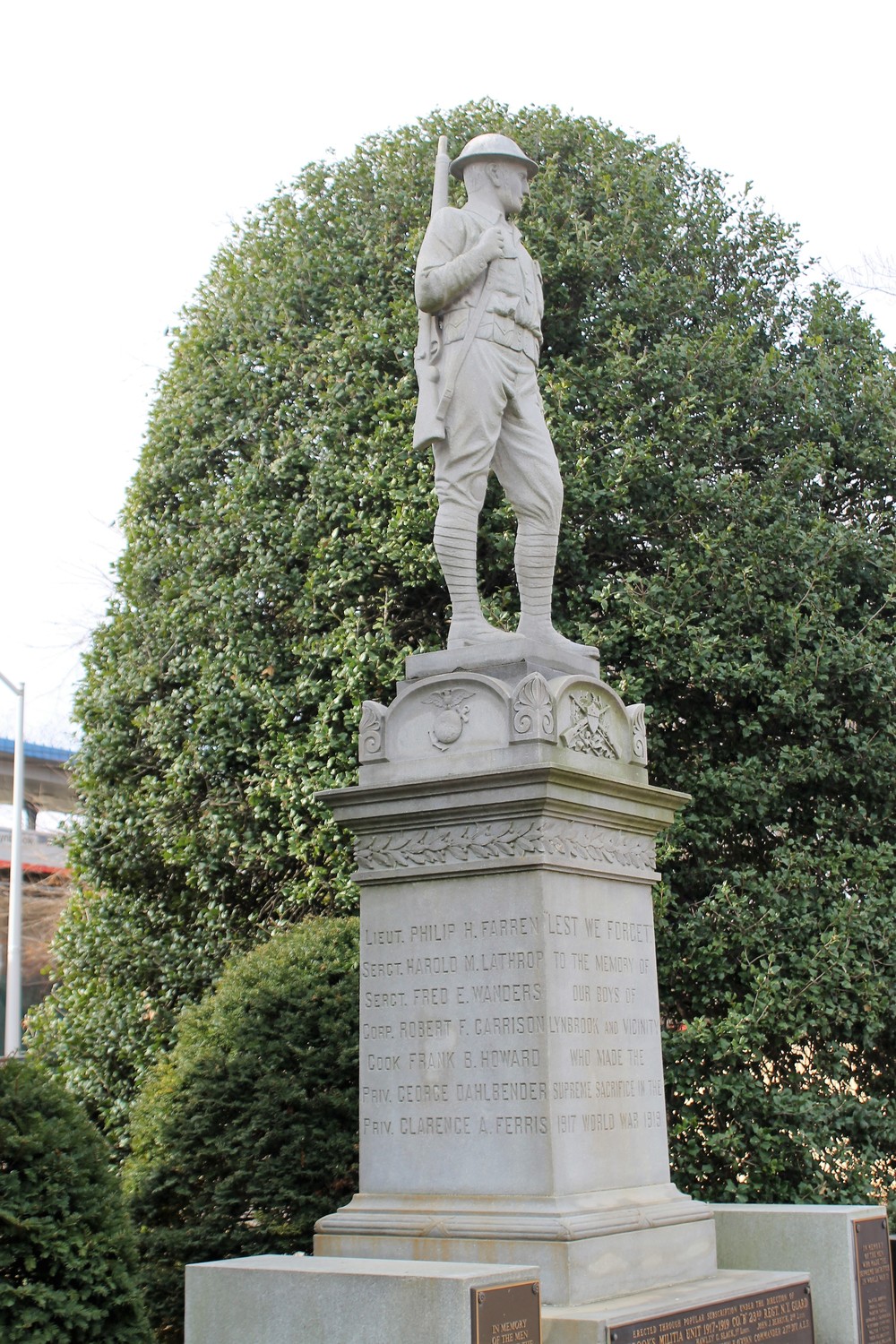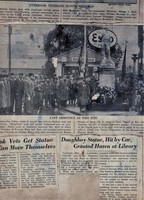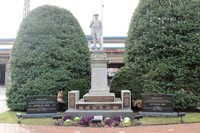Lynbrook’s ‘civil war’ over the Doughboy Monument
Author’s note: While Steve Grogan, a member of American Legion Post 335 and former Lynbrook village trustee, was going through the American Legion’s archive documents, a large amount of old and yellowed newspaper clippings, mostly with dates cut off and without the newspaper’s names, were reviewed. Included with these articles were other articles from the Nassau Daily Review and Nassau Daily Star newspapers. Grogan does not know if the undated articles came from these newspapers. The period of the newspaper articles was from 1931 to 1936.
In this day and age when many people fight to take down statues from past generations and wars, Lynbrook has its own statue that remains standing — the Doughboy Monument. While it is proudly displayed today on the small plot of an island in Saperstein Plaza, the statue was once the center of controversy, which resulted in some newspapers calling it a “village civil war” in the 1930s.
The monument, also once known as the Soldiers and Sailors Monument, or the Doughboy Memorial, is a statue of a World War I soldier built in 1920. It is the centerpiece of the village’s war monuments. On the four-sided pedestal below the Doughboy statue are the names of 15 local soldiers killed in action during World War I.
The statue did not always stand in Saperstein Plaza, and one of its past locations caused a controversy that pitted American Legion Post 335 against the mayor and village board, and especially, against the Lynbrook Library board of trustees.
The Doughboy statue, which reportedly cost $5,000, was commissioned by Lynbrook’s Militia Unit, Company B, 23rd Regiment of the New York National Guard. Philip Stauderman, former Lynbrook village president, and a captain in the Regiment, told the Nassau Daily Star in 1936 that the statue was built through public subscription and “turned over to the Village of Lynbrook after its dedication by General John F. O’Brien, on Presidents’ Day, Oct. 12, 1921.”
The inscription on the bottom of the Doughboy says that General John F. O’Ryan, 27th division commander, dedicated the statue.
According to that same article, the statue was originally going to be placed on donated property owned by Anthony Botty, “proprietor of Botty’s Hotel, which was then located on the corner of Merrick Road and Hempstead Avenue.” For some unreported reason, Botty could not donate the property, and the statue was placed directly on the corner of Merrick Road and Blake Avenue, where an Esso gas station operated.
Not long after the statue was erected, a car hit the structure and knocked the monument off, breaking it. The veterans rebuilt it for $2,200 and put it back on its pedestal.
Present writings beneath the pedestal of the statue say, “Destroyed by a motorist June 6, 1924, reconstructed by popular subscription of the people of Lynbrook under the direction of ex-members of the above militia unit Nov. 24, 1924.”
According to another undated article, the statue had been knocked off its base and repaired by the veterans many times. It was after these repeated repairs that the American Legion, which held annual Armistice Day (Nov. 11, later named Veterans Day) ceremonies in front of the Doughboy — standing out in Merrick Road with cars speeding by — asked village officials to move the statue. From the undated articles, it appears this request first occurred around 1934 or 1935.
In a much later undated article, it was stated that the statue needed to be moved from the Merrick Road site “to make way for the widening of the thoroughfare.”
The American Legion soon proposed that the statue be moved to the property of the Lynbrook Library. Specifically, the corner of the property at Eldert Street and Carpenter Avenue.
The library’s trustees immediately rejected the proposal. They said they felt that the Doughboy shouldn’t be anywhere on the property as it “would mar the architecture of the building.” Charles Guden, a village board trustee, was also against the use of the library property, and “argued that an apartment house might sometime be located on that corner plot.” Another article said Lillian E. Raeburn, vice president of the board, said, “the statue would clutter up the library lawn.”
The Library board put its refusal in a letter addressed to the mayor and village board. “The library site would ruin what is now generally considered as one of the most beautiful libraries,” the letter read. “ … [The statue] would tend to clutter up the lawn. … We don’t want the library grounds to be used as a resting place for everything that can’t be placed elsewhere.”
The Legion responded and voted a “resolution censuring the library board for their attitude.” It read, “The resolution was not made public, but it was made known that it criticized the library officials in no uncertain terms.” It was mailed to the members of the library board.
Mayor Harold G. Wilson then got involved in the issue and appointed a committee to find a site, submitting at the same time a plan for a park on Sunrise Highway and Earle Avenue.
The Legion objected to the mayor appointing a committee, because he did not communicate with the veterans’ organization.
The newly proposed location was also immediately rejected by Legion members because the traffic on Sunrise Highway. It was the same reason they wanted the Doughboy moved from Merrick Road. One article said, “The Legionnaires raised objection to this site on the grounds that traffic conditions would threaten any gatherings.”
Even with the Legion’s rejection of Sunrise Highway, the village went ahead and drew up plans for a statue site at Sunrise and Earle Avenue. The plans were presented to the mayor’s committee, which included members from all the veterans’ organizations. The Legion once again presented its opposition to that location.
“Mayor Wilson said that, in respect to the Legion’s action, the village board had nothing to say as it had appointed a committee to consider the question of a site for the memorial monument and that the board was awaiting its recommendation before doing anything definite,” one article reads.
In later years, that Sunrise Highway site became the Lynbrook Fire Department memorial after three firefighters were killed in 1963. It also honors other firefighters killed in the line of duty and those Lynbrook firefighters who were killed in war.
In an editorial, dated April 18, 1935, titled, “Who is the Boss?” the unknown newspaper stated, “This matter should not rest with the refusal of the library trustees, but should be threshed out and the village board know where they stand.”
Another editorial called the controversy a “village civil war.”
Another article said that the “last excuse” for not moving the statue was the cost of such a move. Company B, 23rd Regiment quickly volunteered to pick up half the cost of the move, which was about $600.
As even more articles appeared in the newspapers about the controversy, the East Rockaway American Legion got involved. Their members had a 3-foot replica made of the Doughboy. It was presented by Commander James W. Brannigan to William Sykes, former Lynbrook commander and chairman of the Lynbrook post’s monument committee.
“Brannigan told Sykes the East Rockaway Legion was tired of hearing about the difficulties Lynbrook was having with its Doughboy Monument, and so had brought the smaller one as a gift [so that] the post could move it more easily.”
Another article said, “East Rockaway Post, American Legion [is] going on record condemning the action of the library board in refusing to accept the monument. Interest of the East Rockaway post was inspired by the fact the names of eight East Rockaway men are inscribed on the monument.”
An editorial on the front page of the Nassau Daily Star, dated Feb. 11, 1936, and titled, “Doughboy Solutions,” stated, “The Lynbrook American Legion can tote the ‘Dough Boy’ around in a suitcase as far as the East Rockaway Legion Post is concerned — in fact, they’d prefer it. Lynbrook’s memorial achieved fame recently when the Lynbrook Public Library board refused to have it on their grounds for aesthetic reasons. … The East Rockaway Legionnaires are sick and tired of hearing about the Lynbrook Legionnaires’ difficulties with the monument.”
But, also in that same newspaper that same day, the headline read, “Board surrenders; Doughboy seizes Lynbrook Library.” Even though the library board was against the proposal, village officials adopted “a resolution authorizing the moving of the ‘Doughboy’ monument from Merrick Road and Blake Avenue to the Lynbrook Public Library grounds.”
“The action was taken following the receipt of a report from the monument committee,” the article continues. The committee had unanimously recommended the library site. The American Legion, joined by the Veterans of Foreign Wars and the Spanish War veterans, voted for the library location. The Doughboy was moved to the site shortly after the Armistice Day ceremonies in 1936.











